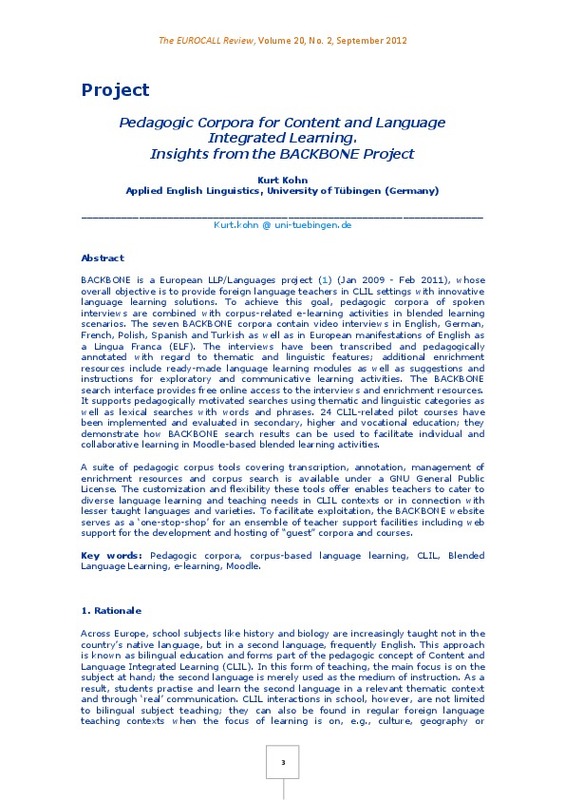Aston, G. (2002). The learner as corpus designer. In B. Kettemann & G. Marko (eds.). Teaching and Learning by Doing Corpus Analysis. Amsterdam: Rodopi, 9-25. https://doi.org/10.1163/9789004334236_004
Aston, G., Bernadini, S. & Stewart, D. (2005). Corpora and Language Learners. Amsterdam: John Benjamins.
Biber, D., Johansson, S., Leech, G., Conrad, S. & Finegan, E. (eds.) (1999). Longman Grammar of Spoken and Written English. Harlow: Pearson Education.
[+]
Aston, G. (2002). The learner as corpus designer. In B. Kettemann & G. Marko (eds.). Teaching and Learning by Doing Corpus Analysis. Amsterdam: Rodopi, 9-25. https://doi.org/10.1163/9789004334236_004
Aston, G., Bernadini, S. & Stewart, D. (2005). Corpora and Language Learners. Amsterdam: John Benjamins.
Biber, D., Johansson, S., Leech, G., Conrad, S. & Finegan, E. (eds.) (1999). Longman Grammar of Spoken and Written English. Harlow: Pearson Education.
Boulton, A. (2011). Data-driven learning: The perpetual enigma. In S. Goźdź-Roszkowski (ed.). Explorations across Languages and Corpora. Frankfurt/M: Peter Lang, 563-580.
Braun, S. & Slater C. (2009). Pedagogical fields and needs analysis. BACKBONE Report 3.2 [http://projects.ael.uni-tuebingen.de/backbone > Project documentation].
Braun, S. & Slater C. (2011). Pedagogical assessment and evaluation. BACKBONE Report 3.3 [http://projects.ael.uni-tuebingen.de/backbone > Project documentation].
Braun, S. (2005). From pedagogically relevant corpora to authentic language learning contents. ReCALL, 17(1), 47-64. https://doi.org/10.1017/S0958344005000510
Braun, S. (2007). Integrating corpus work into secondary education: From data-driven learning to needs-driven corpora. ReCALL, 19(3), 307-328. https://doi.org/10.1017/S0958344007000535
Braun, S. (2010). Getting past 'Groundhog Day': Spoken multimedia corpora for student-centred corpus exploration. In T. Harris & M. Moreno Jaén (eds). Corpus Linguistics in Language Teaching. Frankfurt: Peter Lang, 75-98.
Braun, S., Kohn, K. & Mukherjee, J. (2006). Corpus Technology and Language Pedagogy: New Resources, New Tools, New Methods. Frankfurt/M: Peter Lang.
Flowerdew, L. (2009). Applying corpus linguistics to pedagogy. A critical evaluation. International Journal of Corpus Linguistics, 14(3), 393-417. https://doi.org/10.1075/ijcl.14.3.05flo
Granger, S., Dagneaux, E. & Meunier, F. (2002). The International Corpus of Learner English. Louvain-la-Neuve: Presses Universitaires de Louvain.
Guth, S. & Helm, F. (eds.) (2010). Telecollaboration 2.0. Bern: Peter Lang. https://doi.org/10.3726/978-3-0351-0013-6
Hoffstaedter, P. & K. Kohn (2009). Real language and relevant language learning activities: insights from the SACODEYL project. In A. Kirchhofer & J. Schwarzkopf (Eds.), The Workings of the Anglosphere. Contributions to the Study of British and US-American Cultures. Trier: WVT, 291-303.
Hoffstaedter, P. (2011). Compilation of the BACKONE pedagogical corpora. BACKBONE Report 5.1-7 [http://projects.ael.uni-tuebingen.de/backbone > Project documentation].
Hoffstaedter, P., Kohn, K. & Widmann, J. (2009). Corpus-enhanced language learning and teaching. Part 2: Using pedagogic corpora for form and communication integrated learning. BACKBONE Report 3.1 (part b) [http://projects.ael.uni-tuebingen.de/backbone > Project documentation].
Johns, T. & King, Ph. (1991). Classroom Concordancing. Birmingham: University of Birmingham.
Kohn, K. & Hoffstaedter, P. (2011). Pilot courses. BACKBONE Report 6 [http://projects.ael.uni-tuebingen.de/backbone > Project documentation]
Kohn, K. & Warth, C. (2011). Web Collaboration for Intercultural Language Learning. A Guide for Language Teachers, Teacher Educators and Student Teachers. Insights from the icEurope Project. Münster: MV-Wissenschaft.
Kohn, K. (2008). Telos Language Partner: DIY authoring for content-based language learning. In A. Gimeno (ed.). Computer Assisted Language Learning: Authoring Tools for Web-Based CALL. Valencia: Universidad Politécnica de Valencia, 157-174.
Kohn, K. (2009). Computer assisted foreign language learning. In K. Knapp & B. Seidlhofer (eds.). Foreign Language Communication and Learning. Handbooks of Applied Linguistics, Volume 6. Berlin: Mouton-de Gruyter, 573-603.
Kohn, K., Widmann, J. & Wetzel, D. (2011). Pedagogic corpus search tool. BACKBONE Report 4.3 [http://projects.ael.uni-tuebingen.de/backbone > Project documentation].
Kohn, K., Widmann, J., Wetzel, D. & Hoffstaedter, P. (2011). Pedagogic corpus enrichment tools. BACKBONE Report 4.2 [http://projects.ael.uni-tuebingen.de/backbone > Project documentation].
Kohn, K.& Esteves, M. (2009). The use of educational e-learning equipment and applications in foreign language classes: a questionnaire-based survey. Wide Minds Comenius Network Report (Workpackage 5: Developing Multilingualism through Digital Content). [http://projects.ael.uni-tuebingen.de/backbone > Project documentation].
Kohn, K., Glombitza, A.& Helbich, G. (2008). Perceived potential of educational ICT in European schools. EcoMedia Socrates Comenius 3 Network (ed.). ICT in European Schools, ePortfolios and Open Content. St. Michael: der wolf verlag, 35-42. [http://projects.ael.uni-tuebingen.de/backbone > Project documentation].
Kohn, Kurt, Petra Hoffstaedter & Johannes Widmann (2010). BACKBONE - pedagogic corpora for content & language integrated learning. In A. Gimeno Sanz (ed.). New Trends in Computer-Assisted Learning: Working Together. Madrid: Macmillan ELT, 157-162.
Pérez-Paredes, P. & Alcaraz-Calero, J.M. (2009). Developing annotation solutions for online data driven learning. ReCALL, 21(1), 55-75. https://doi.org/10.1017/S0958344009000093
Pérez-Paredes, P. (2010). Corpus linguistics and language education in perspective: appropriation and the possibilities scenario. In T. Harris & M. Moreno Jaén (eds). Corpus Linguistics in Language Teaching. Frankfurt: Peter Lang, 53-73.
Pérez-Paredes, P., Alcaraz. J.M. & Sánchez-Tornel, M. (2011). Pedagogic corpus compilation. BACKBONE Report 4.1 [http://projects.ael.uni-tuebingen.de/backbone > Project documentation].
Sinclair, J. (ed.) (1987). Collins COBUILD English Language Dictionary. London: Collins.
Sinclair, J. (ed.) (1990). Collins COBUILD English Grammar. Helping Learners with Real English. London: Collins.
Sinclair, J. (ed.) (2004). How to use Corpora in Language Teaching. Amsterdam: John Benjamins. https://doi.org/10.1075/scl.12
Swain, M. (2005). The Output Hypothesis: Theory and Research. In E. Hinkel (2005). Handbook on Research in Second Language Teaching and Learning. Mahwah, NJ: Lawrence Erlbaum, 471-484.
Tribble, Ch. & Jones, G. (1990) Concordances in the Classroom: A Resource Book for Teachers. Harlow: Longman.
Tribble, Ch. (1997). Improvising corpora for ELT: quick-and-dirty ways of developing corpora for language teaching. In B. J. Lewandowska-Tomaszczyk & P. J. Melia (eds.). PALC-97: Practical Applications in Language Corpora. Łódź: Łódź University Press, 106-117.
Wichman, A., Fligelstone, S., McEnery, T. & Knowles, G. (eds.) (1998). Teaching and Language Corpora. London: Longman.
Widdowson, H. G. (1991). The description and prescription of language". In J. Alatis (ed.). Linguistics and Language Pedagogy: the State of the Art. Washington, DC: Georgetown University, 11-24.
Widdowson, H. G. (1998). Context, community and authentic language. TESOL Quarterly, 32(4), 705-716. https://doi.org/10.2307/3588001
Widdowson, H.G. (2003). Defining Issues in English Language Teaching. Oxford: OUP.
Widmann, J., Kohn, K. & Ziai, R. (2010). The SACODEYL search tool: exploiting corpora for language learning purposes. In Frankenberg-Garcia, A., Flowerdew, L. & Aston, G. (eds.). New Trends in Teaching and Language Corpora. Proceedings of the TaLC 2008. London: Continuum, 321-327.
[-]







![HTML file [HTML]](/themes/UPV/images/html.png)

